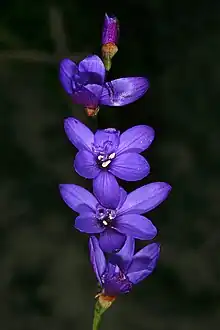| Geissorhiza aspera | |
|---|---|
 | |
| Scientific classification | |
| Kingdom: | Plantae |
| Clade: | Tracheophytes |
| Clade: | Angiosperms |
| Clade: | Monocots |
| Order: | Asparagales |
| Family: | Iridaceae |
| Genus: | Geissorhiza |
| Species: | G. aspera |
| Binomial name | |
| Geissorhiza aspera Goldblatt | |
| Synonyms[1] | |
| |
Geissorhiza aspera, also known as the blue satin flower or blou sysie, is a geophyte from South Africa.
Description
This velvety-stemmed geophyte grows 10–35 cm (3.9–13.8 in) tall.[2] Plants may, however, be larger or smaller than the typical range. Both the soil conditions and moisture play a role in height.[3] Each plant may branch up to three times, although branching is not always present.[3] The corm is covered in woody tunics.[2] The sword-shaped leaves have thickened margins and midribs. Normally plants will have three leaves, each of which is about the same length as the stem or slightly longer.[3]
Star-shaped flowers are present in August and September.[2][4] It flowers best after a wet winter. Each inflorescence has between three and seven flowers. They are usually dark blue or violet in colour, sometimes with a darker center.[4] The northern populations (Olifants River Valley, Gifberg and near Bitterfontein) are often white.[5][6] These flowers may still be blue on the outsides of the tepals.[6] The filaments are usually not all the same length, particularly in northern populations.[3] The green floral bracts dry and turn a rusty brown at the tips as the flowers open.[3] Plants typically seed in October.[4]
Distribution and habitat
This species is endemic to South Africa. This species was believed to be limited to the Western Cape until 2012, when a population in Namaqualand in the Northern Cape.[6] It is found growing between Gifberg and Agulhas, where it is most common on moist sandy soils at altitudes of 70–100 m (230–330 ft).[2][4]
Ecology
The flowers are most commonly pollinated by money beetles, which are attracted the darker area at the center of the flower.[4] It is also known to be pollinated by the Cape honey bee, a Braunsapsis species, Anisonyx ursus, a bombyllidae species and Anthophora diversipes.[5]
Conservation
This species is classified as being of least concern by the South African National Biodiversity Institute (SANBI) as it is common and widespread.[7] It is also able to tolerate disturbance and is common in disturbed habitats, such as roadsides and parks.[7]
References
- ↑ "Geissorhiza aspera". Global Biodiversity Information Facility. Retrieved 24 September 2023.
- 1 2 3 4 Manning, John; Goldblatt, Peter (2012). Plants of the Greater Cape Floristic Region : 1: the core Cape flora (PDF). Pretoria: South African National Biodiversity Institute, SANBI. ISBN 978-1-919976-74-7. OCLC 852384288.
- 1 2 3 4 5 e-Flora of South Africa. v1.42. 2023. South African National Biodiversity Institute. http://ipt.sanbi.org.za/iptsanbi/resource?r=flora_descriptions&v=1.42
- 1 2 3 4 5 Cowell, Carly (October 2006). "Geissorhiza aspera". PlantAfrica. Retrieved 24 September 2023.
- 1 2 Bothalia, African Biodiversity & Conservation. South African National Biodiversity Institute.
- 1 2 3 Goldblatt, P.; Manning, J. C. (2016-09-01). "Review of species limits in Geissorhiza leipoldtii (Iridaceae: Crocoideae) and G. heterostyla with the recognition of new taxa plus important new records in the genus". South African Journal of Botany. 106: 29–34. doi:10.1016/j.sajb.2016.05.006. ISSN 0254-6299.
- 1 2 Raimondo, D. (2013). "Geissorhiza aspera Goldblatt National Assessment: Red List of South African Plants version 2020.1". SANBI Red List of South African Plants. Retrieved 24 September 2023.
External links
- Dressler, S.; Schmidt, M. & Zizka, G. (2014). "Geissorhiza aspera". African plants – a Photo Guide. Frankfurt/Main: Forschungsinstitut Senckenberg.
 Media related to Geissorhiza aspera at Wikimedia Commons
Media related to Geissorhiza aspera at Wikimedia Commons Data related to Geissorhiza aspera at Wikispecies
Data related to Geissorhiza aspera at Wikispecies